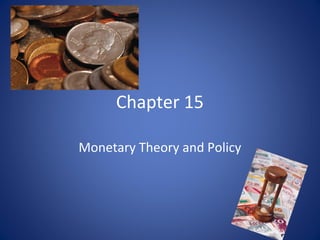Chapter15 monetarytheory-and-policy-140831163822-phpapp02
- 1. Chapter 15 Monetary Theory and Policy
- 2. ŌĆó Why would people hold money? ŌĆō Transactions Demand for Money ŌĆō Precautionary Demand for Money ŌĆō Speculative Demand for Money The Demand for Money
- 3. ŌĆó The three motivates for holding money combine to create a demand for money curve. ŌĆō Def: The demand for money curve represents the money people hold at different possible interest rates, ceteris paribus. ŌĆō Why is it downward sloping? ŌĆō Example of Graph The Demand for Money Curve
- 4. Example of a Graph
- 5. ŌĆó The supply of money is a vertical line (MS) implying that the quantity of money supplied is independent of the interest rate ŌĆō Why? ŌĆō Show equilibrium The Equilibrium Interest Rate
- 7. What happens if the Fed increases the money supply? ŌĆó The opportunity cost of holding money falls enough that the public is willing to hold the now larger stock of money
- 8. How the Fed Controls the MS? ŌĆó The establishment of reserve requirements for banks ŌĆó Buying and selling U.S. government securities and other financial assets in the open market ŌĆó The volume of loans extended to banks and other institutions ŌĆó The interest rate it pays banks on funds held as reserves
- 10. Recent Monetary Policy ŌĆó Increase in the monetary base from $828 billion at mid-year 2008 to $1.63 trillion in early 2009 to more than $2 trillion in 2010. ŌĆó Lower interest rates
- 13. Example of lowering the interest rate
- 14. Interest Rates and Investment ŌĆó Suppose the Fed purchases U.S. government bonds. ŌĆō What happens to Investment? ŌĆō What happens to AD?
- 15. Example of Investment and Interest Rates
- 16. Adding the Short-Run Aggregate Supply Curve ŌĆó For a given shift of the aggregate demand curve, the steeper the short-run aggregate supply curve, the smaller the increase in real GDP and the larger the increase in the price level.
- 17. Example of Graph of SRAS
- 18. ŌĆó Def: Monetarism is the theory that changes in the money supply directly determine changes in prices, real GDP, and employment ŌĆō They put the spotlight on the money supply. They argue that to predict the condition of the economy, you simply look at the money supply. ŌĆō Too much money supply = higher inflation ŌĆō Too less money supply= unemployment and deflation The Monetarist View of the Role of Money
- 19. ŌĆó Def: The equation of exchange is an accounting identity that stateŌĆÖs the MS time velocity of money is equal to total spending: MV=PY The Equation of Exchange
- 20. ŌĆó It is assumed by classical economists that V and Y(real output) are fairly constant. ŌĆō Why is this true? ŌĆō Def: The Quantity Theory of Money states that changes in the money supply are directly related to changes in the affect of price level. The Quantity Theory of Money
- 21. ŌĆó Today, we do not think that V is constant and the employment does not always operate at full employment ŌĆō M& P are correlated, but not perfectly correlated. Modern Monetarism
- 22. Targets Before 1982 ŌĆó Between World War II and October 1979- the Fed attempted to stabilize interest rates. ŌĆó Friedman said this made monetary policy a source of instability in the economy because changes in the money supply reinforced fluctuations in the economy. ŌĆō He said pay less attention to interest rates and instead focus on a steady and predictable growth in the money supply ŌĆō Monetary rule
- 23. Targets After 1982 ŌĆó Less force on a steady and predictable growth in the money supply. ŌĆó The force was on a targeted federal funds rate.























